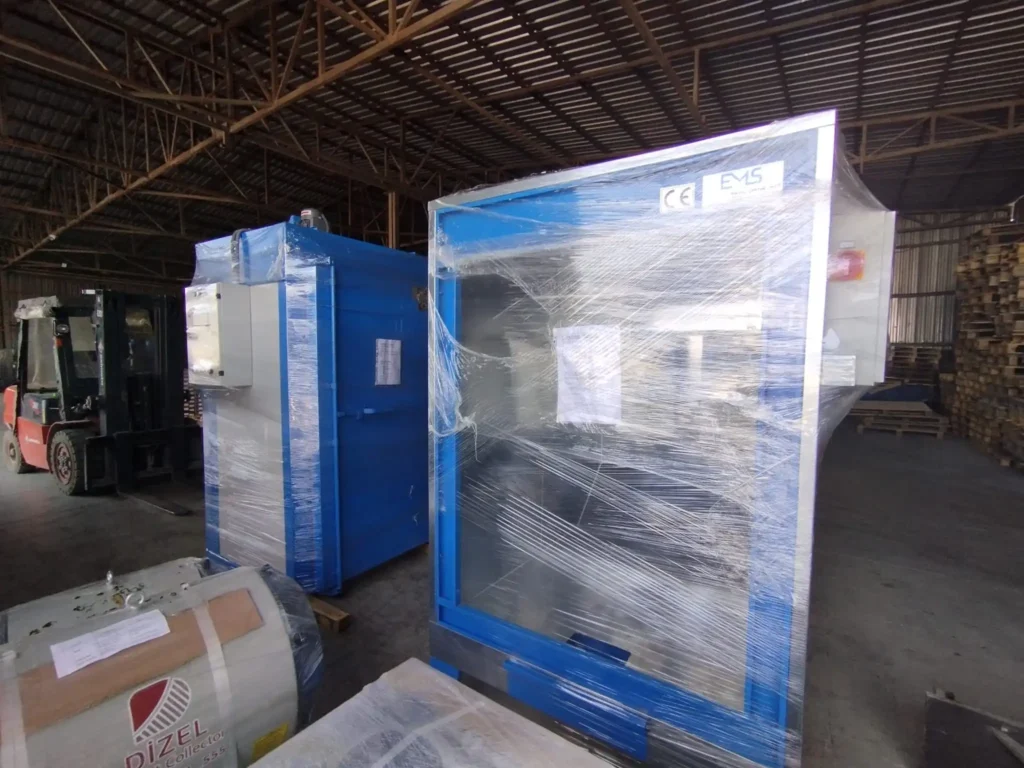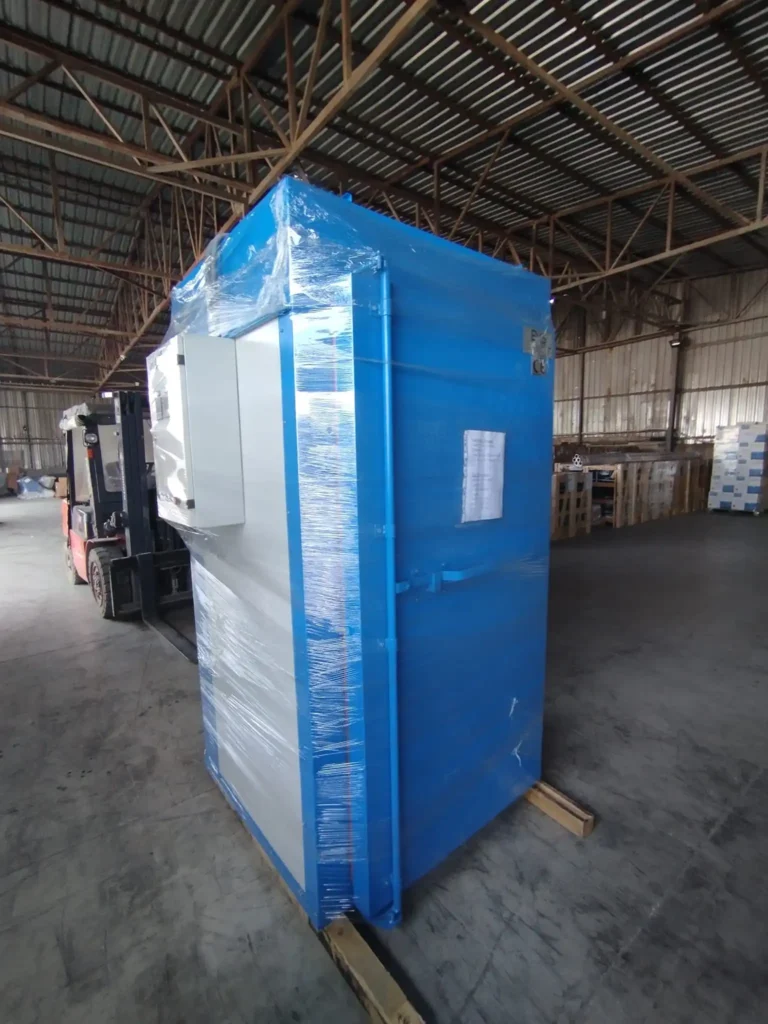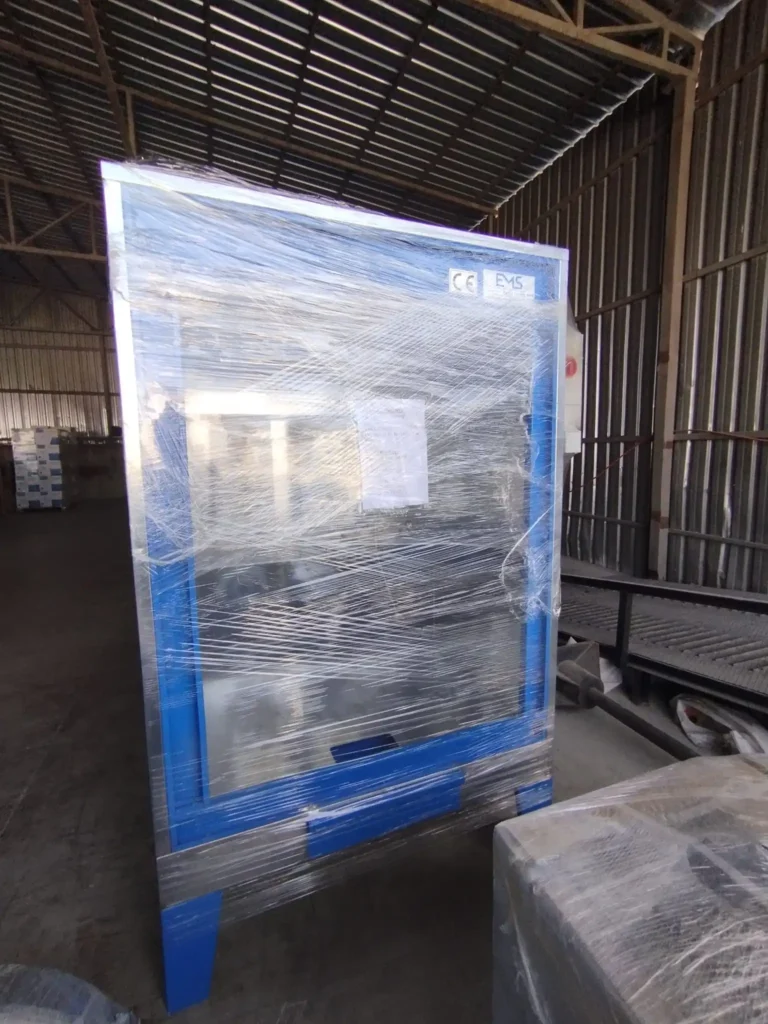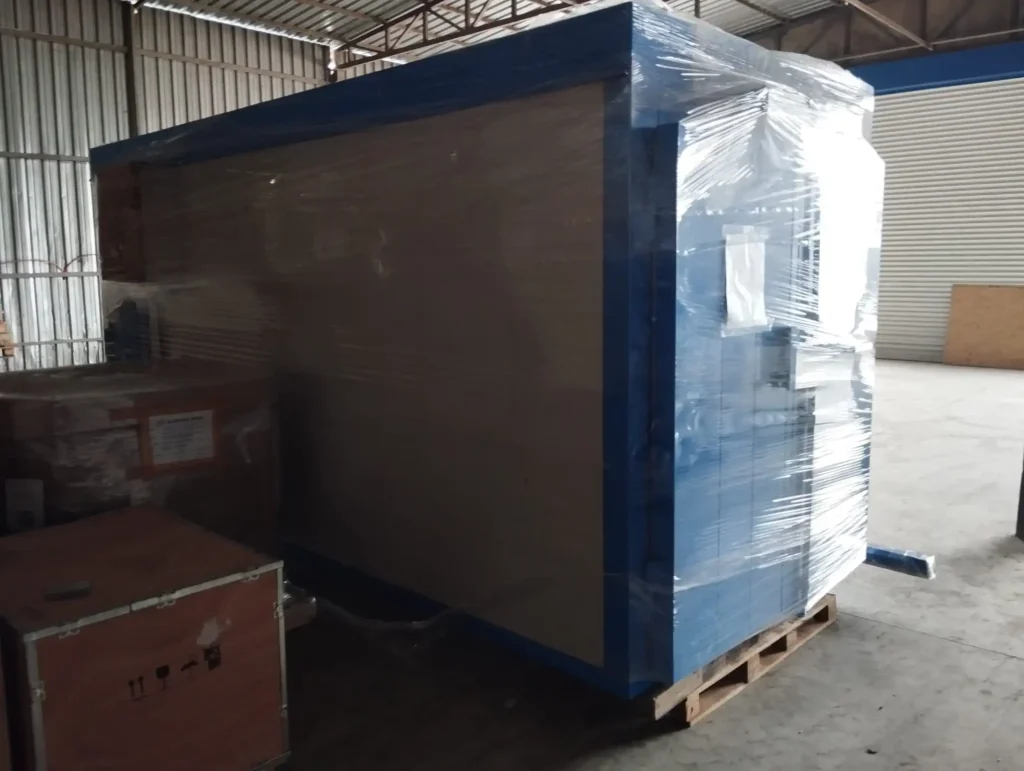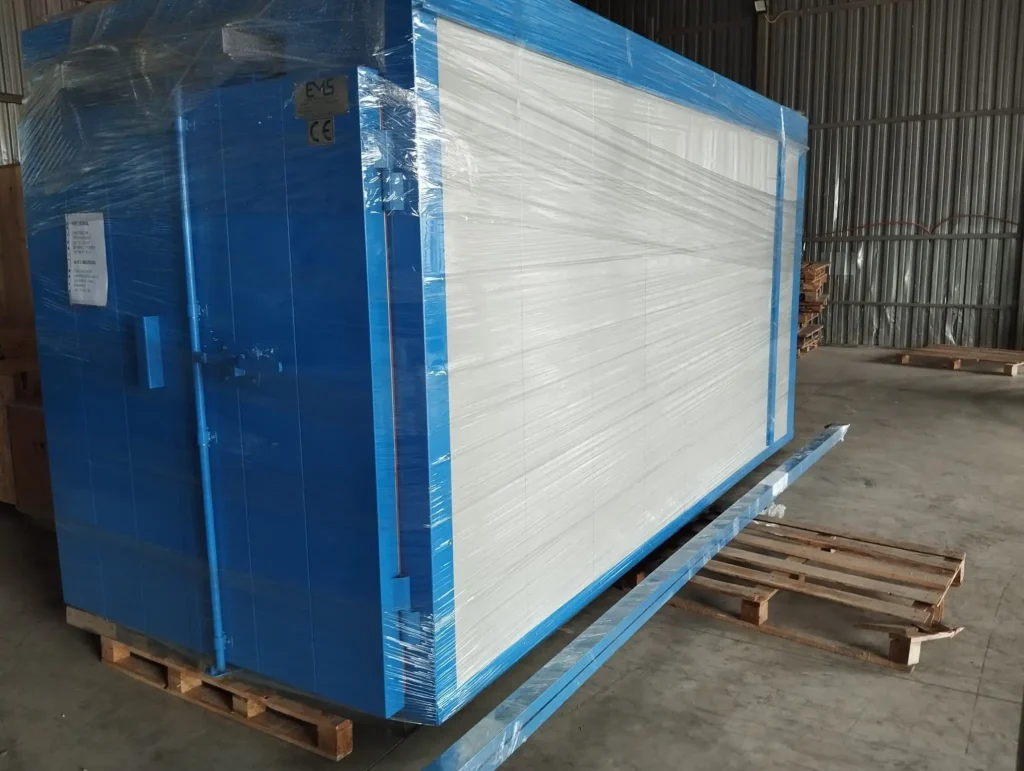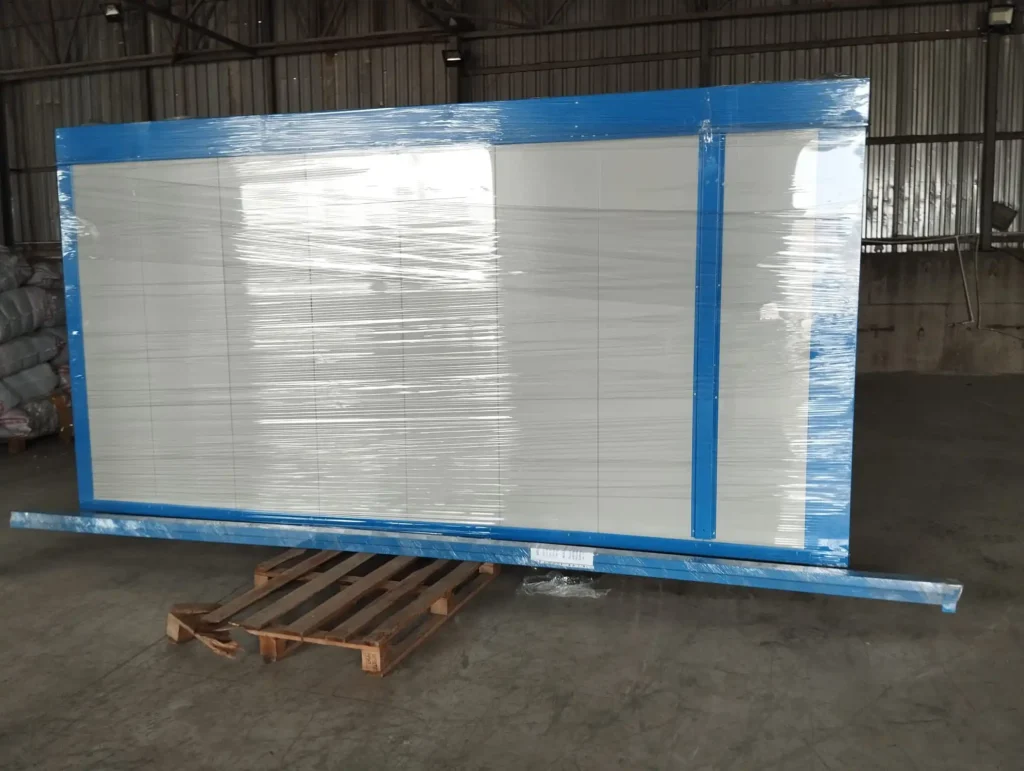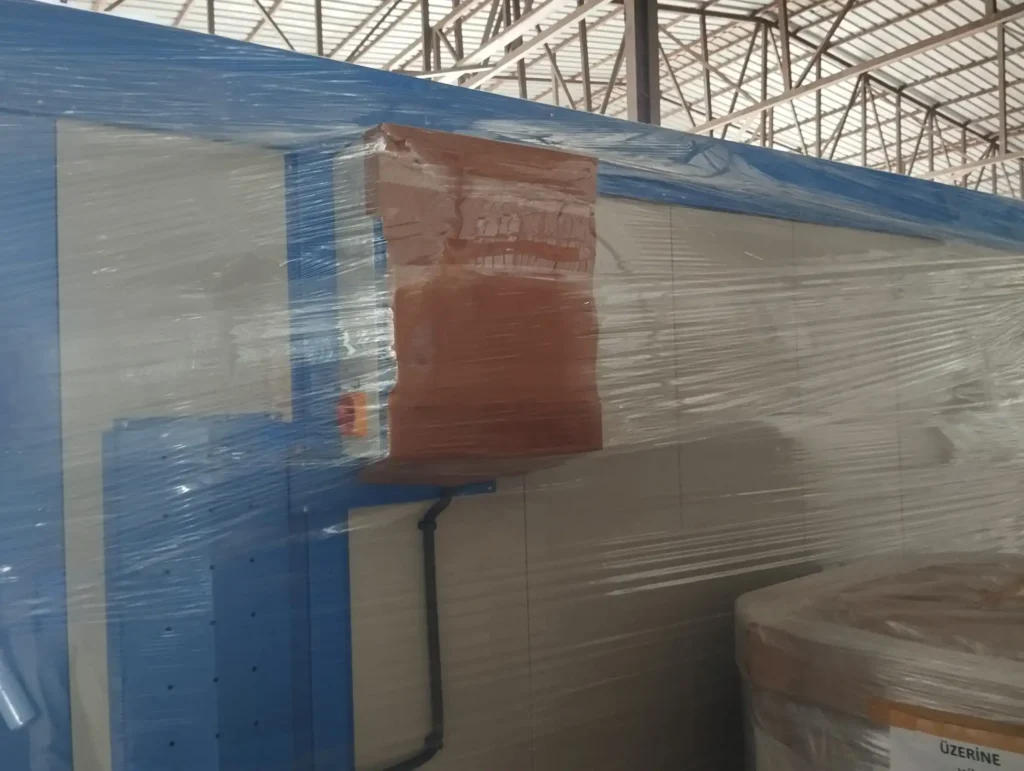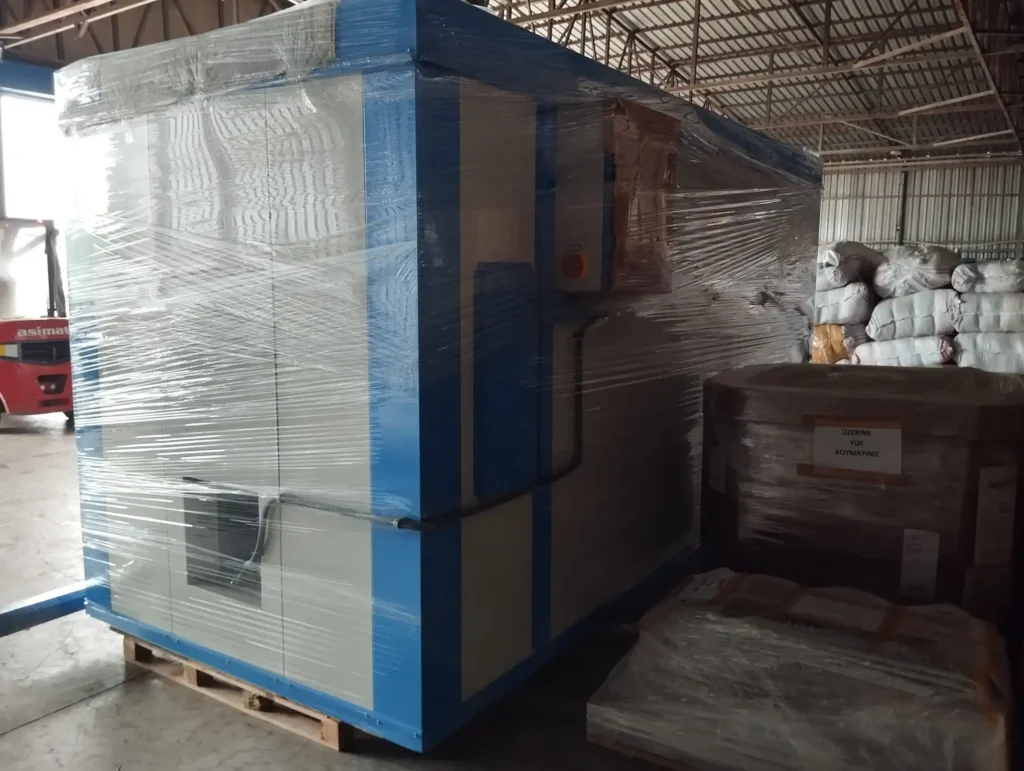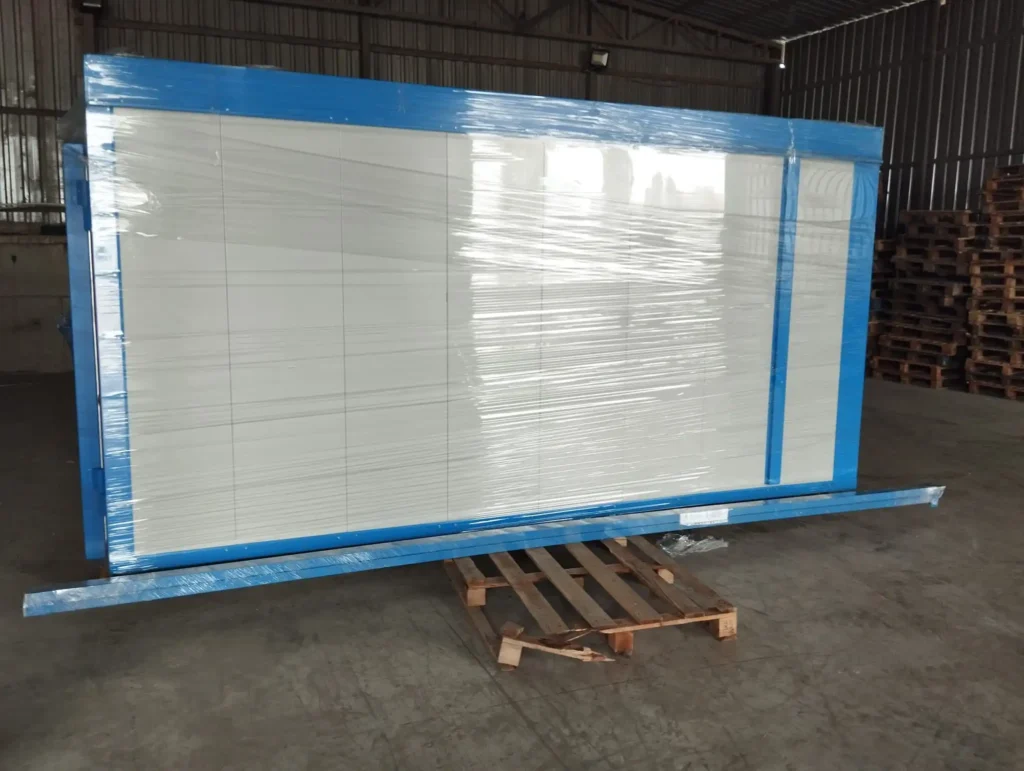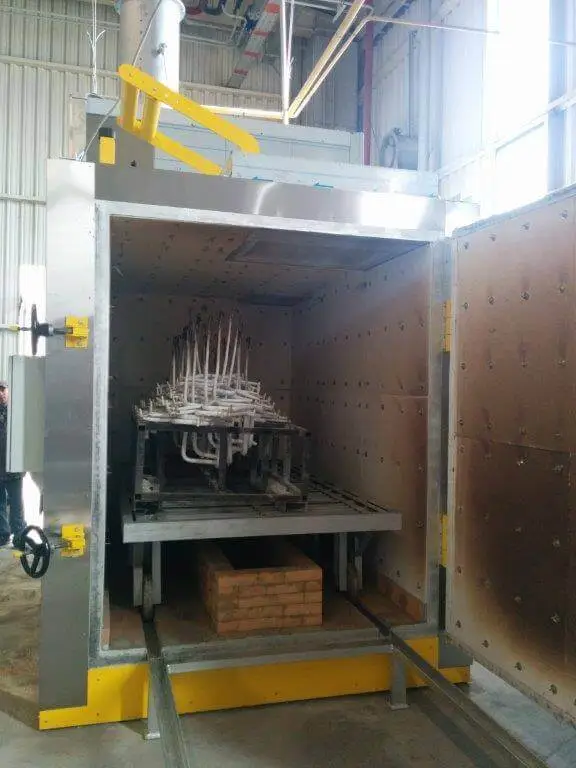
Burn off ovens are used in the powder coating industry to remove old or excess powder coating from metal parts or racks. The process involves heating the coated parts in an oven to a temperature where the powder coating breaks down and turns into ash, which can be easily brushed or blown off. Here are some key points about burn-off ovens for powder coating:
- Temperature and Time:
- Burn-off ovens typically operate at temperatures ranging from 500 to 800 degrees Celsius (932 to 1472 degrees Fahrenheit).
- The duration of the process depends on factors such as the type and thickness of the coating, but it usually takes a few hours.
- Construction:
- Burn-off ovens are constructed with materials and insulation that can withstand high temperatures.
- The interior is designed to promote even heating to ensure that all parts of the coated items reach the necessary temperature for effective powder coating removal.
- Control Systems:
- Advanced burn-off ovens are equipped with precise temperature control systems to maintain uniform heat throughout the process.
- Some ovens also feature programmable controllers for automation and ease of use.
- Safety Features:
- Safety is crucial when working with high temperatures. Burn-off ovens often include safety features such as temperature alarms, ventilation systems, and emergency shut-off mechanisms.
- Proper ventilation is essential to remove fumes generated during the burn-off process.
- Environmental Considerations:
- Burn-off ovens must comply with environmental regulations. Some models are equipped with afterburners or other pollution control devices to minimize emissions.
- Energy Efficiency:
- Energy-efficient burn-off ovens are designed to minimize energy consumption while achieving the required temperature levels.
- Cleaning and Maintenance:
- Regular cleaning and maintenance are necessary to ensure the oven’s continued effectiveness and longevity.
- Proper cleaning procedures help remove accumulated ash and residue from previous burn-off cycles.
- Size and Capacity:
- The size of the burn-off oven should accommodate the parts or racks being processed.
- Larger industrial ovens may have multiple chambers or conveyors to handle larger quantities of coated items.
- Integration with Powder Coating Line:
- In some manufacturing setups, burn-off ovens are integrated into a continuous powder coating line for efficient workflow.
When considering a burn-off oven for powder coating operations, it’s important to choose a model that suits the specific needs and production requirements of your business. Additionally, adherence to safety guidelines and environmental regulations is crucial to ensure a secure and environmentally responsible powder coating removal process.
Burn off Oven
A burn-off oven is a specialized thermal processing unit designed for the removal of coatings, particularly powder coatings, from metal surfaces. The process involves subjecting the coated objects to elevated temperatures, typically ranging from 500 to 800 degrees Celsius (932 to 1472 degrees Fahrenheit). The objective is to thermally degrade the coating, turning it into ash that can be easily removed.
The construction of a burn-off oven is engineered to withstand the extreme temperatures involved in the process. The inner chamber is carefully designed to promote uniform heating, ensuring that all parts of the coated items reach the necessary temperature for efficient coating removal. High-quality insulation materials are used to prevent heat loss and maintain energy efficiency.
Control systems in modern burn-off ovens play a critical role in achieving precise temperature management. Temperature controllers ensure that the oven maintains a consistent and even heat throughout the process, contributing to the effectiveness of the coating removal. Some advanced models also feature programmable controllers, allowing for automation and ease of use.
Safety is a paramount consideration in burn-off oven design. These ovens incorporate various safety features to protect both equipment and operators. Temperature alarms, emergency shut-off mechanisms, and proper ventilation systems are integrated to mitigate potential risks associated with high-temperature operations. Ventilation is crucial not only for safety but also to eliminate fumes generated during the burn-off process.
Environmental considerations are addressed through the inclusion of afterburners or other pollution control devices. These devices help minimize emissions, ensuring compliance with environmental regulations. As sustainability becomes a more significant concern in industrial processes, the development of burn-off ovens that are both effective and environmentally friendly is a focal point of innovation.
Regular cleaning and maintenance are essential to keep a burn-off oven operating effectively. Proper cleaning procedures help remove accumulated ash and residue from previous burn-off cycles, preventing any compromise in performance. The size and capacity of the burn-off oven should be chosen based on the specific needs of the application, ensuring that it accommodates the dimensions and quantities of coated items to be processed.
In industrial settings, burn-off ovens may be integrated into a continuous powder coating line for seamless workflow and enhanced efficiency. This integration allows for a streamlined process where coated items can be transported through the burn-off oven as part of an automated production line.
In summary, a burn-off oven is a specialized piece of equipment designed for the thermal removal of coatings, offering a combination of precision, safety features, and environmental considerations crucial in the powder coating industry.
Powder Coating Removal with Burn off Ovens
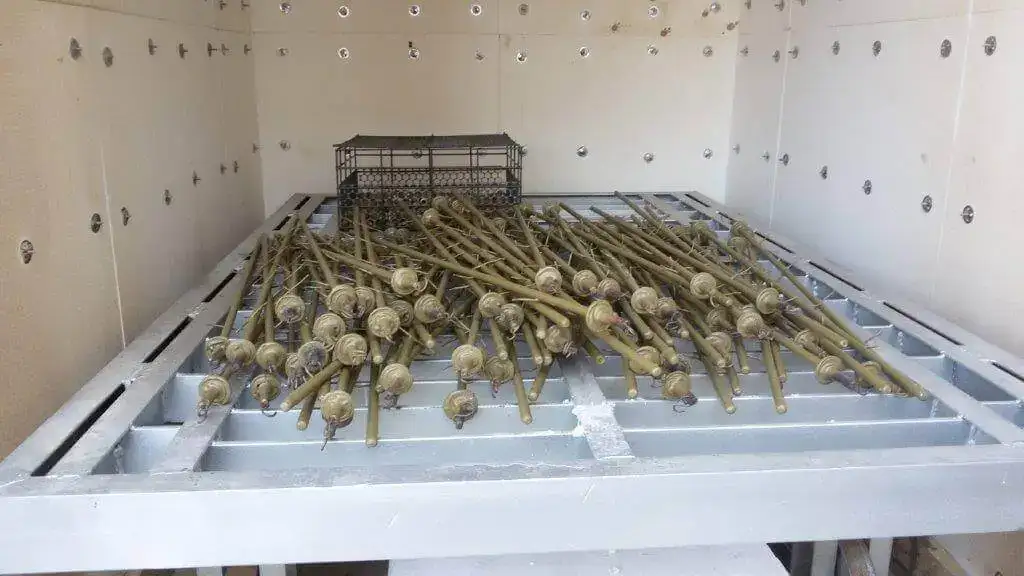
Powder coating removal refers to the process of eliminating existing powder coatings from metal surfaces, typically to prepare the substrate for recoating or refurbishment. This task is accomplished through various methods, with one of the most efficient being the use of specialized equipment such as burn-off ovens.
One of the primary reasons for powder coating removal is the need to refresh or change the coating on metal parts or products. Over time, coatings can degrade due to exposure to environmental elements, wear, or changes in aesthetic preferences. The removal process is essential to maintain the quality and appearance of the coated items.
The burn-off oven, a key tool in powder coating removal, operates by subjecting the coated objects to high temperatures, causing the powder coating to thermally degrade. The powder coating undergoes a chemical transformation, turning into ash that can be easily brushed or blown off, leaving the metal substrate ready for recoating.
In addition to burn-off ovens, other methods of powder coating removal include abrasive blasting, chemical stripping, and mechanical methods. However, burn-off ovens are often preferred for their efficiency, especially when dealing with large or intricate metal parts.
The effectiveness of powder coating removal is influenced by factors such as the type of powder coating used, its thickness, and the substrate material. Burn-off ovens provide a controlled and uniform heating environment, ensuring that the entire coated surface reaches the required temperature for successful coating breakdown.
Powder coating removal is a critical step in the powder coating refurbishment process. It allows manufacturers and finishers to extend the life of coated products, update finishes, or correct coating defects. The ability to remove and recoat items contributes to sustainability by reducing the need for new materials and minimizing waste.
When considering powder coating removal, it’s essential to choose the appropriate method based on the specific requirements of the application. Burn-off ovens, with their precision, efficiency, and safety features, play a significant role in achieving reliable and consistent results in the powder coating removal process.
High Temperature Oven
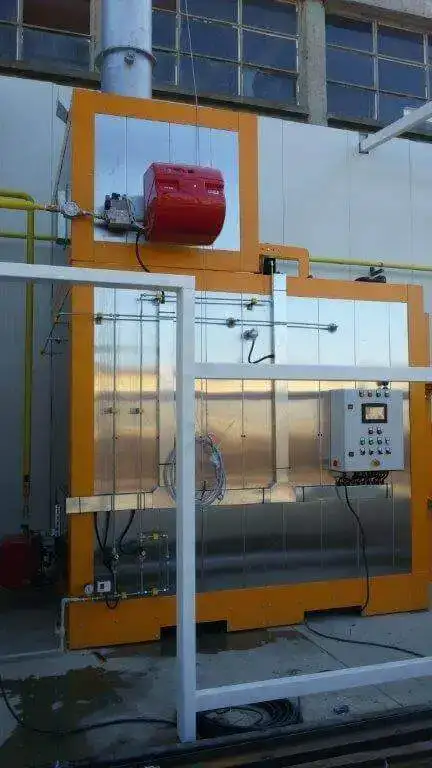
A high-temperature oven is an industrial thermal processing unit designed to achieve and maintain elevated temperatures for various applications. These ovens are engineered to withstand extreme heat levels, typically exceeding those found in conventional ovens, making them suitable for processes that require intense heat, such as burn-off operations in powder coating removal.
The construction of high-temperature ovens involves the use of robust materials that can withstand the demanding conditions of prolonged exposure to extreme temperatures. Specialized insulation is incorporated to minimize heat loss and ensure energy efficiency during operation. The interior design is optimized for uniform heat distribution, crucial for applications like heat treatment, annealing, and, in the context of powder coating, thermal degradation for coating removal.
Temperature control systems in high-temperature ovens are essential for achieving precise and consistent heating. These ovens are equipped with advanced controllers that allow operators to set and maintain specific temperature profiles. The capability to control temperature variations ensures that the oven meets the requirements of diverse industrial processes, ranging from curing to burn-off procedures.
Safety features are paramount in the design of high-temperature ovens. Given the extreme conditions they operate in, these ovens often incorporate multiple layers of protection. Emergency shut-off mechanisms, temperature alarms, and robust ventilation systems are implemented to safeguard both equipment and personnel from potential hazards associated with high-temperature operations.
One of the notable applications of high-temperature ovens is in burn-off processes for powder coating removal. In this context, the oven plays a crucial role in elevating the temperature to the point where the powder coating undergoes thermal degradation, facilitating its subsequent removal. The efficiency of this process is highly dependent on the oven’s ability to reach and maintain the required high temperatures consistently.
Beyond powder coating removal, high-temperature ovens find applications in heat treatment of metals, ceramics, and other materials. Processes such as annealing, tempering, and stress relieving rely on the controlled application of high temperatures, and these ovens provide the necessary environment for such treatments.
In summary, a high-temperature oven is a specialized industrial tool designed to achieve and maintain elevated temperatures for various applications. In the realm of powder coating, it is a key component in burn-off processes, demonstrating its versatility in contributing to different thermal applications across industries.
Coating Stripping:
Coating stripping is a process that involves the removal of coatings, such as paint or powder coating, from surfaces to prepare them for refinishing, repainting, or other applications. This technique is particularly relevant in industries where the quality of the substrate needs to be restored, or when a change in coating type or color is desired. Among the various methods employed for coating stripping, burn-off ovens stand out as an effective and efficient solution.
Burn-Off Ovens in Coating Stripping:
Burn-off ovens play a pivotal role in the coating stripping process, especially when dealing with powder coatings. The method involves subjecting coated objects to elevated temperatures, typically ranging from 500 to 800 degrees Celsius (932 to 1472 degrees Fahrenheit). The intense heat causes the coating to thermally degrade, turning into ash that can be easily removed, leaving the substrate clean and ready for further treatment.
The efficiency of burn-off ovens in coating stripping lies in their ability to uniformly heat the entire surface of the coated object. This ensures that even complex shapes or intricate parts are thoroughly exposed to the high temperatures, resulting in the complete breakdown of the coating. The controlled heating environment prevents damage to the underlying substrate, making it a preferred method for delicate or intricate surfaces.
The coating stripping process is highly dependent on the characteristics of the coating being removed, such as its composition, thickness, and adherence to the substrate. Burn-off ovens provide a versatile solution that can handle a wide range of coatings, making them suitable for diverse industrial applications.
Advantages of Coating Stripping with Burn-Off Ovens:
- Efficiency: Burn-off ovens are known for their efficiency in quickly and thoroughly removing coatings, reducing downtime in industrial processes.
- Versatility: These ovens can handle various coating types, making them suitable for use in industries such as automotive, aerospace, and general manufacturing.
- Preservation of Substrate Integrity: The controlled heating environment minimizes the risk of substrate damage during the coating stripping process, ensuring the integrity of the underlying material.
- Environmental Considerations: Some burn-off ovens incorporate afterburners or pollution control devices to minimize emissions, aligning with environmental regulations and sustainability goals.
- Automation and Precision: Advanced burn-off ovens feature programmable controllers, allowing for automation and precise control over temperature profiles, contributing to consistent and reliable coating stripping results.
In conclusion, coating stripping is a crucial step in the maintenance and refurbishment of various industrial components. Burn-off ovens, with their ability to efficiently remove coatings while preserving substrate integrity, stand as a key technology in the realm of coating stripping processes.
Thermal Cleaning:
Thermal cleaning is a specialized process that utilizes high temperatures to remove contaminants, residues, or coatings from various surfaces, components, or equipment. This method is particularly effective in applications where traditional cleaning techniques may be impractical or insufficient. Burn-off ovens play a significant role in thermal cleaning processes, providing a controlled and efficient environment for the removal of unwanted materials.
Principles of Thermal Cleaning:
Thermal cleaning relies on the application of heat to break down and eliminate contaminants or coatings. In the context of burn-off ovens, the temperature is elevated to a level where the undesired substances undergo thermal degradation, transforming into ash or volatile byproducts. The result is a cleaned surface, free from contaminants, oxidation, or coatings.
Applications of Thermal Cleaning:
- Coating Removal: Thermal cleaning is widely used for the removal of coatings, including paint, varnish, and powder coatings. Burn-off ovens create an environment where coatings break down into ash, allowing for easy removal and subsequent refinishing.
- Resin and Polymer Removal: In industries such as plastics manufacturing or molding, thermal cleaning is employed to remove residues of polymers or resins from molds, tooling, and equipment.
- Oil and Grease Removal: Thermal cleaning is effective in eliminating oil, grease, and other hydrocarbon-based contaminants from metal surfaces, making it valuable in applications where cleanliness is critical, such as in the aerospace or automotive industries.
- Decomposition of Organic Contaminants: Burn-off ovens can be used to decompose organic contaminants, including adhesives, sealants, or organic residues, leaving surfaces clean and ready for further processing.
Key Features of Burn-Off Ovens in Thermal Cleaning:
- Temperature Control: Burn-off ovens provide precise temperature control, allowing operators to tailor the cleaning process to the specific requirements of the materials being treated.
- Uniform Heating: The design of burn-off ovens ensures uniform heating across the treated surfaces, promoting consistent and thorough cleaning results.
- Versatility: These ovens can be adapted for various applications, accommodating different materials and geometries, making them versatile tools in industrial cleaning processes.
- Safety Measures: Burn-off ovens are equipped with safety features such as emergency shut-off mechanisms and proper ventilation systems to ensure the safe operation of thermal cleaning processes.
- Environmental Considerations: Some burn-off ovens incorporate pollution control devices, aligning with environmental regulations and minimizing the impact of emissions generated during thermal cleaning.
In summary, thermal cleaning, facilitated by burn-off ovens, offers an efficient and versatile solution for removing coatings and contaminants from a wide range of materials and surfaces, contributing to improved cleanliness, product quality, and operational efficiency in various industries.
Paint Stripping Oven:
A paint stripping oven is a specialized industrial thermal processing unit designed for the removal of paint coatings from surfaces, particularly those applied to metal substrates. The process involves subjecting painted objects to elevated temperatures, causing the paint to undergo thermal degradation, ultimately resulting in its removal. Paint stripping ovens are essential tools in industries where the quality, appearance, or functionality of painted surfaces needs restoration or modification.
Key Components and Features:
- Construction: Paint stripping ovens are constructed with materials capable of withstanding high temperatures. The inner chamber is designed for uniform heating, ensuring that the entire painted surface is exposed to the necessary temperature for effective paint removal.
- Temperature Control: These ovens are equipped with precise temperature control systems, allowing operators to set and maintain specific temperature profiles. This control is crucial for achieving optimal results in paint stripping while avoiding damage to the underlying substrate.
- Ventilation Systems: Proper ventilation is integrated into paint stripping ovens to manage fumes and byproducts generated during the thermal degradation of paint. This not only ensures a safe working environment but also addresses environmental considerations.
- Safety Measures: Paint stripping ovens incorporate safety features such as emergency shut-off mechanisms and temperature alarms to protect both equipment and personnel during high-temperature operations.
- Efficiency and Speed: The controlled heating environment of paint stripping ovens contributes to efficient and rapid paint removal, minimizing downtime in industrial processes. This efficiency is particularly beneficial when dealing with large quantities of painted components.
- Compatibility with Various Paint Types: Paint stripping ovens are versatile and can be adapted to handle different types of paint, including solvent-based, water-based, epoxy, or polyurethane coatings. This versatility makes them suitable for diverse applications.
Process of Paint Stripping:
- Loading: Painted objects are loaded into the oven, either manually or through automated systems, positioning them for optimal exposure to heat.
- Heating Phase: The oven is heated to temperatures sufficient for the thermal breakdown of the paint. This phase is carefully controlled to prevent substrate damage.
- Thermal Degradation: The elevated temperature causes the paint to undergo thermal degradation, breaking down into ash or other easily removable forms.
- Cooling and Removal: After the heating phase, the objects are allowed to cool, and the residue (ash or degraded paint) is removed, leaving the substrate clean and ready for further treatment or finishing.
Applications:
- Automotive Industry: Paint stripping ovens are commonly used to remove paint coatings from automotive parts, facilitating refinishing or color changes.
- Aerospace Industry: In aerospace applications, paint stripping ovens are employed to prepare aircraft components for recoating or inspection.
- Metal Fabrication: Industries involved in metal fabrication use paint stripping ovens to clean metal surfaces before welding or other processes.
In conclusion, paint stripping ovens are indispensable tools in industries where the removal of paint coatings is a crucial step in the maintenance, refurbishment, or modification of painted surfaces. Their precision, efficiency, and safety features make them valuable assets in achieving consistent and reliable results in the paint stripping process.
Industrial Baking Oven:
An industrial baking oven is a specialized thermal processing unit designed for controlled heat application to cure, dry, or bake various materials, particularly coatings like paints, adhesives, and powder coatings. This type of oven is a critical component in manufacturing processes where precise temperature and time control are essential for achieving desired material properties.
Key Features and Components:
- Temperature Control Systems: Industrial baking ovens are equipped with sophisticated temperature control systems, ensuring precise and consistent heat application. This is crucial for achieving optimal curing or baking conditions for different materials.
- Uniform Heating: The design of these ovens promotes even distribution of heat throughout the chamber, ensuring that all parts of the material or coated object are subjected to the desired temperature. This uniform heating contributes to consistent results and prevents uneven curing or drying.
- Conveyor Systems: In many industrial baking ovens, conveyor systems are integrated to facilitate the continuous movement of materials through the oven. This is particularly useful for large-scale production processes, ensuring a continuous and efficient workflow.
- Exhaust Systems: Proper ventilation and exhaust systems are incorporated to remove any fumes, volatile components, or byproducts generated during the curing or baking process. This not only ensures a safe working environment but also contributes to environmental compliance.
- Insulation: High-quality insulation materials are used in the construction of industrial baking ovens to minimize heat loss, improve energy efficiency, and maintain a stable internal temperature.
Applications:
- Powder Coating Curing: Industrial baking ovens play a crucial role in the powder coating process. After the application of powder coating onto a substrate, the coated items are conveyed through the oven to cure the powder and create a durable finish.
- Paint Curing: In automotive and other manufacturing industries, industrial baking ovens are utilized to cure paint coatings on vehicle parts or other painted surfaces. The controlled heat ensures the paint dries and hardens to the desired specifications.
- Adhesive Curing: For industries using adhesives or sealants, industrial baking ovens are employed to cure or set the adhesive, providing the necessary strength and bonding properties.
- Polymerization Processes: Industrial baking ovens are used in processes where polymerization is required, such as in the production of composite materials, polymer coatings, or molded plastic components.
- Food Processing: In the food industry, industrial baking ovens are utilized for baking, drying, or cooking various food products, ranging from bread and pastries to snacks and ready-to-eat meals.
Benefits:
- Increased Efficiency: The continuous and uniform heating provided by industrial baking ovens contributes to efficient production processes.
- Quality Control: Precise temperature control ensures consistent results, promoting high-quality cured or baked products.
- Reduced Energy Consumption: Proper insulation and advanced control systems contribute to energy efficiency, reducing overall operating costs.
In summary, industrial baking ovens are versatile tools used in a wide range of industries for curing, drying, or baking processes. Their precise temperature control, uniform heating, and compatibility with various materials make them essential for achieving quality and efficiency in manufacturing operations.
Coating Degradation:
Coating degradation refers to the process by which a protective or decorative coating on a substrate undergoes deterioration or breakdown, often as a result of environmental exposure, wear, or aging. Understanding the mechanisms of coating degradation is crucial in various industries, and addressing this issue is essential for maintaining the performance, appearance, and integrity of coated materials.
Causes of Coating Degradation:
- Environmental Exposure: Coatings on outdoor structures or objects are constantly exposed to environmental elements such as sunlight (UV radiation), moisture, temperature fluctuations, and pollutants. These exposures can lead to degradation over time.
- Chemical Exposure: Coatings in industrial settings may be exposed to chemicals, solvents, acids, or other aggressive substances, leading to chemical breakdown or corrosion of the coating.
- Mechanical Stress: Coatings on surfaces subject to mechanical stress, abrasion, or impact can experience degradation due to physical wear and tear.
- Microbial Growth: In certain environments, coatings may be susceptible to microbial growth, leading to biofilm formation and degradation of the coating.
- Improper Application: Incorrect application methods, inadequate surface preparation, or using incompatible materials can result in poor adhesion and premature coating failure.
Methods of Coating Degradation Assessment:
- Visual Inspection: Regular visual inspections can identify changes in coating appearance, such as cracking, blistering, peeling, or discoloration, indicating potential degradation.
- Adhesion Testing: Evaluating the adhesion strength of a coating helps assess its ability to bond to the substrate. Poor adhesion is a sign of potential degradation.
- Chemical Resistance Testing: Assessing the coating’s resistance to specific chemicals or solvents helps determine its susceptibility to chemical degradation.
- Accelerated Weathering Tests: Simulating environmental conditions in accelerated weathering chambers can provide insights into how coatings will perform over an extended period, helping predict long-term degradation.
- Thickness Measurement: Monitoring changes in coating thickness can indicate wear or erosion, providing information about the extent of degradation.
Prevention and Mitigation:
- Proper Surface Preparation: Ensuring that the substrate is properly cleaned, primed, and prepared before coating application enhances adhesion and reduces the risk of degradation.
- Material Selection: Choosing coatings with suitable resistance to environmental factors and chemicals for specific applications is crucial for long-term performance.
- Regular Maintenance: Implementing routine maintenance, including cleaning, inspections, and recoating when necessary, helps prevent and address early signs of degradation.
- Corrosion Protection: Combining coatings with corrosion protection measures, such as inhibitors or sacrificial anodes, can enhance overall durability.
- Environmental Controls: Implementing environmental controls, such as climate-controlled storage or protective enclosures, can minimize the impact of harsh environmental conditions.
In summary, coating degradation is a complex process influenced by various factors. Understanding the causes, employing proper testing methods, and implementing preventive measures are key elements in managing and mitigating coating degradation, ensuring the longevity and effectiveness of protective coatings in diverse applications.
Heat-Cleaning Equipment:
Heat-cleaning equipment refers to specialized machinery designed to use elevated temperatures as a primary method for cleaning, stripping, or processing materials. This equipment harnesses the power of heat to achieve tasks such as removing coatings, eliminating contaminants, or altering material properties. Heat-cleaning processes are widely employed in industrial settings for their efficiency, versatility, and environmentally friendly characteristics.
Key Types of Heat-Cleaning Equipment:
- Burn-Off Ovens: Burn-off ovens are designed to remove coatings, such as paint or powder coatings, from metal surfaces through controlled exposure to high temperatures. The process involves thermal degradation of the coating, turning it into ash for easy removal.
- Heat Treatment Furnaces: Heat treatment furnaces are used to alter the physical or mechanical properties of materials through carefully controlled heating and cooling cycles. This equipment is vital in processes like annealing, tempering, and stress relieving.
- Thermal Cleaning Systems: These systems use heat to eliminate contaminants, residues, or coatings from various surfaces. They are employed in applications such as cleaning molds, removing polymers, or stripping adhesive residues.
- Industrial Baking Ovens: Industrial baking ovens, often associated with curing coatings, also fall under the category of heat-cleaning equipment. They are used to cure or dry coatings, adhesives, or polymers on materials.
Advantages of Heat-Cleaning Equipment:
- Efficiency: Heat-cleaning processes are often faster and more efficient compared to traditional cleaning methods, reducing downtime in industrial operations.
- Uniform Heating: Specialized equipment ensures uniform heating, promoting consistent results across treated surfaces.
- Versatility: Heat-cleaning equipment can be adapted for various applications, making it suitable for cleaning, stripping, curing, and heat treatment processes.
- Reduced Environmental Impact: Some heat-cleaning methods, such as those involving burn-off ovens, can be more environmentally friendly as they generate fewer chemical byproducts compared to certain chemical stripping methods.
- Preservation of Substrate Integrity: Controlled heating minimizes the risk of substrate damage during the cleaning or stripping process, making it suitable for delicate or intricate surfaces.
Applications of Heat-Cleaning Equipment:
- Powder Coating Removal: Burn-off ovens are used for efficiently removing powder coatings from metal parts in the powder coating industry.
- Metal Heat Treatment: Heat treatment furnaces are employed in the metallurgical industry for processes like hardening, tempering, and annealing of metal components.
- Plastics Industry: Thermal cleaning systems are utilized to remove polymers or residues from molds, extrusion equipment, and other tools in the plastics manufacturing sector.
- Aerospace and Automotive: Heat-cleaning equipment plays a crucial role in preparing components for these industries by removing coatings, residues, or contaminants.
- Composite Material Manufacturing: Heat-cleaning processes are used in the production of composite materials, ensuring proper curing and bonding of resin matrices.
In summary, heat-cleaning equipment represents a diverse range of machinery crucial for various industrial processes. By harnessing the power of heat, these systems contribute to efficient, uniform, and environmentally conscious methods for cleaning, stripping, and processing materials in different sectors.
Powder Coating Refurbishment:
Powder coating refurbishment is the process of renewing or restoring the appearance and functionality of powder-coated surfaces. Powder coating, a popular finishing method for various materials, provides a durable and attractive finish. Over time, factors such as wear, environmental exposure, or changes in aesthetics may necessitate refurbishment. This involves the removal of the existing powder coating and the application of a new coating to enhance or restore the coated item.
Key Steps in Powder Coating Refurbishment:
- Coating Removal: The first step in refurbishing a powder-coated item involves the removal of the existing coating. This is often achieved through methods like burn-off ovens, abrasive blasting, or chemical stripping, depending on the type of substrate and the condition of the existing coating.
- Surface Preparation: After coating removal, the substrate needs thorough cleaning and preparation. This step may include abrasive cleaning, sanding, or other surface treatments to ensure proper adhesion of the new powder coating.
- Application of New Powder Coating: Once the substrate is prepared, the new powder coating is applied. The item is typically electrostatically sprayed with dry powder particles, which adhere to the surface. The coated item is then cured in an industrial baking oven to create a durable and uniform finish.
- Curing: Curing is a critical step in the powder coating process. The coated item is heated in an industrial baking oven to a specific temperature, causing the powder particles to melt and form a continuous, smooth coating. This ensures adhesion and durability of the new powder coating.
- Quality Inspection: After curing, the refurbished item undergoes a quality inspection to ensure that the new powder coating meets the desired standards for appearance, adhesion, and functionality.
Advantages of Powder Coating Refurbishment:
- Cost-Effectiveness: Refurbishing powder-coated items is often more cost-effective than completely replacing them, especially for large or intricate components.
- Environmental Sustainability: Refurbishment reduces the need for new materials and minimizes waste, aligning with environmental sustainability goals.
- Extended Lifespan: Proper refurbishment can extend the lifespan of coated items, delaying the need for replacement and contributing to long-term cost savings.
- Aesthetic Enhancement: Refurbishment allows for changes in color or finish, providing an opportunity to update the aesthetics of coated items to meet current trends or branding requirements.
- Preservation of Substrate: Refurbishment techniques, including careful coating removal methods, contribute to preserving the integrity of the underlying substrate, preventing damage during the process.
Applications:
- Automotive Industry: Refurbishing powder-coated parts of vehicles, such as wheels or chassis components, is common in the automotive industry to maintain appearance and functionality.
- Architectural Elements: Powder coating refurbishment is applied to architectural elements, such as metal railings, fences, or outdoor furniture, to restore and protect surfaces exposed to environmental conditions.
- Industrial Equipment: Components of industrial machinery or equipment with powder coatings may undergo refurbishment to extend their service life and maintain performance.
- Consumer Goods: Powder coating refurbishment is used in the restoration of consumer goods like appliances, furniture, and outdoor equipment to enhance their appearance and durability.
In conclusion, powder coating refurbishment is a valuable process in various industries, offering a cost-effective and environmentally conscious way to renew the appearance and functionality of powder-coated items. The combination of effective coating removal, surface preparation, and application of new powder coatings contributes to the longevity and quality of refurbished components.
Afterburner System:
An afterburner system, also known as an afterburner or secondary combustion chamber, is a critical component in industrial processes where the combustion of volatile compounds, contaminants, or exhaust gases needs to be completed to enhance environmental protection and comply with emission regulations. Afterburners are commonly integrated into various systems, including burn-off ovens, industrial furnaces, and thermal oxidizers.
Key Components and Functions:
- Combustion Chamber: The afterburner system consists of a secondary combustion chamber designed to provide additional residence time and high temperatures for the combustion of unburned or partially burned gases.
- Ignition Source: An ignition source, such as a burner or pilot flame, is used to initiate combustion in the afterburner. This ensures that the gases entering the chamber are exposed to high temperatures, facilitating their complete combustion.
- Temperature Control: Afterburners are equipped with temperature control systems to maintain and regulate the temperature within the combustion chamber. This ensures that the gases are sufficiently heated for thorough combustion.
- Retention Time: The design of the afterburner allows for extended residence time, ensuring that the gases spend enough time at high temperatures to complete the combustion process. This is crucial for achieving effective destruction of pollutants.
- Air Supply: Adequate air supply is provided to support combustion. The control of air-to-fuel ratios is essential to optimize combustion efficiency and minimize the generation of undesirable byproducts.
Functions and Applications:
- Emission Control: The primary function of an afterburner system is to control and reduce emissions of volatile organic compounds (VOCs), hazardous air pollutants (HAPs), and other pollutants generated in industrial processes.
- Burn-Off Ovens: In burn-off ovens used for powder coating removal, afterburners are employed to burn off the volatile byproducts generated during the thermal degradation of coatings. This helps minimize the release of pollutants into the atmosphere.
- Thermal Oxidizers: Afterburners are integral components of thermal oxidizers, which are used for the treatment of industrial exhaust gases containing pollutants. The afterburner ensures the destruction of pollutants before the gases are released into the atmosphere.
- Industrial Furnaces: Afterburner systems can be integrated into industrial furnaces to enhance the combustion of volatile compounds in furnace exhaust gases, contributing to cleaner emissions.
- Environmental Compliance: Afterburners play a crucial role in helping industries meet environmental regulations by ensuring the thorough combustion of pollutants, resulting in reduced emissions and improved air quality.
Advantages:
- Pollution Control: Afterburners effectively reduce the emission of pollutants, contributing to environmental protection and regulatory compliance.
- Efficiency: The high temperatures and controlled combustion in afterburners enhance the efficiency of pollutant destruction, leaving minimal unburned or partially burned compounds.
- Versatility: Afterburner systems can be adapted for various industrial applications, making them versatile tools in emission control strategies.
- Safety: Integration of afterburners enhances the safety of industrial processes by minimizing the release of harmful substances into the environment.
In summary, afterburner systems are vital components in industrial processes where the complete combustion of pollutants is essential for environmental compliance. Their integration into systems like burn-off ovens and thermal oxidizers ensures effective pollution control, contributing to sustainable and environmentally responsible industrial practices.
Batch Processing Oven:
A batch processing oven is an industrial thermal processing unit designed for the simultaneous heat treatment or processing of multiple items within a single chamber. This type of oven is suitable for various applications across industries where a batch-wise approach is more practical or efficient than continuous processing. Batch processing ovens are utilized for activities such as curing, baking, drying, annealing, or other heat treatment processes.
Key Features of Batch Processing Ovens:
- Chamber Design: Batch processing ovens typically feature a spacious chamber with racks, trays, or shelves to accommodate multiple items or batches of items. The design allows for uniform heat distribution to all items within the chamber.
- Temperature Control: These ovens are equipped with precise temperature control systems to maintain the desired temperature throughout the processing cycle. This ensures consistent and accurate results for all items in the batch.
- Insulation: High-quality insulation materials are used to minimize heat loss and improve energy efficiency, especially during prolonged processing cycles.
- Ventilation Systems: Batch ovens incorporate proper ventilation systems to ensure the removal of moisture, fumes, or byproducts generated during the processing, contributing to a safe working environment.
- Control Panels: Advanced control panels with programmable features allow operators to set and manage various parameters, including temperature, cycle duration, and other specific requirements for different processes.
Applications of Batch Processing Ovens:
- Curing and Heat Treatment: Batch ovens are commonly used for the curing of coatings, heat treatment of metal components, or the annealing of materials. The ability to process multiple items simultaneously increases operational efficiency.
- Baking and Drying: In industries like food processing or ceramics manufacturing, batch ovens are employed for baking or drying processes where multiple items can be processed at once.
- Sterilization: Batch processing ovens are utilized in medical, pharmaceutical, or research facilities for the sterilization of equipment, glassware, or other items.
- Composite Material Curing: Industries involved in the production of composite materials use batch ovens for the curing of resin matrices, ensuring uniform and controlled curing for multiple components.
- Research and Development: Batch ovens provide a controlled environment for research and development activities, allowing scientists and engineers to test and analyze the effects of heat treatment on various materials.
Advantages of Batch Processing Ovens:
- Versatility: Batch ovens are versatile and can be adapted for various processes, making them suitable for different industries and applications.
- Efficiency: Simultaneously processing multiple items in a batch enhances operational efficiency and reduces processing time compared to single-item processing.
- Flexibility: Batch processing allows for flexibility in handling different materials or product configurations within a single oven, accommodating diverse production requirements.
- Cost-Effective: For applications where continuous processing is not necessary, batch ovens offer a cost-effective solution by providing the required capacity without the complexity of continuous systems.
- Quality Control: Precise temperature control and uniform heating contribute to consistent and high-quality results across all items in a batch.
In summary, batch processing ovens are essential tools in various industries where simultaneous heat treatment or processing of multiple items is advantageous. Their versatility, efficiency, and ability to accommodate different processes make them valuable assets in manufacturing, research, and development environments.
Convection Oven:
A convection oven is a type of oven that utilizes the principles of convection to enhance cooking, baking, or heating processes. Unlike conventional ovens that rely on radiant heat, convection ovens feature a fan and exhaust system, promoting the circulation of hot air within the oven chamber. This circulating air results in more even heat distribution, faster cooking times, and improved browning of food items.
Key Features of Convection Ovens:
- Fan System: The primary distinguishing feature of convection ovens is the inclusion of a fan. This fan circulates hot air throughout the oven, ensuring a consistent temperature around the food items being cooked.
- Even Heat Distribution: The circulating hot air eliminates hot spots within the oven, providing uniform heat to all sides of the food. This results in more even cooking or baking and reduces the need for turning or rotating dishes.
- Faster Cooking Times: The efficient heat distribution and convection process typically lead to faster cooking or baking times compared to traditional ovens. This can be advantageous in both domestic and commercial settings.
- Browning and Crisping: Convection ovens are known for their ability to brown and crisp the outer layers of food items. The circulating hot air promotes caramelization and enhances the texture of baked goods, roasts, and other dishes.
- Multiple Cooking Racks: Many convection ovens come with multiple cooking racks, allowing users to cook or bake different items simultaneously without flavors transferring between dishes.
Applications of Convection Ovens:
- Baking: Convection ovens are widely used for baking a variety of items, including bread, pastries, cookies, and cakes. The even heat distribution contributes to consistent results.
- Roasting: Roasting meats, vegetables, or poultry is a common application of convection ovens. The circulating hot air helps achieve a crispy exterior while keeping the interior moist.
- Broiling: Convection ovens often have a broil setting that utilizes the circulating hot air to quickly cook and brown the top of dishes, such as casseroles or melted cheese on open-faced sandwiches.
- Dehydrating: Some convection ovens have a dehydrating function, making them suitable for preparing homemade dried fruits, jerky, or herbs.
- Cooking Multiple Dishes: The ability to cook multiple dishes simultaneously without flavor transfer makes convection ovens suitable for preparing complete meals efficiently.
Advantages of Convection Ovens:
- Efficient Cooking: Faster cooking times and even heat distribution contribute to energy efficiency and reduced cooking durations.
- Consistent Results: The uniform heat ensures consistent cooking or baking results, making convection ovens reliable for achieving desired outcomes.
- Versatility: Convection ovens can handle a variety of cooking methods, offering versatility for different culinary applications.
- Time Savings: The faster cooking times provided by convection ovens can lead to time savings, making them valuable in busy kitchens.
- Crispiness and Browning: Enhanced browning and crispiness of food items contribute to the overall quality and appeal of the finished dishes.
In summary, convection ovens are versatile appliances known for their efficient and even heat distribution, making them popular choices for both home and professional kitchens. Their ability to improve cooking times and produce consistent, high-quality results makes them valuable tools for a wide range of culinary applications.
Composite Curing Oven:
A composite curing oven is a specialized thermal processing unit designed for the curing of composite materials, particularly those used in the aerospace, automotive, and manufacturing industries. Composite materials, which often consist of resin matrices and reinforcing fibers, require controlled heat and pressure to undergo the curing process, ensuring proper bonding and the development of desired material properties.
Key Features of Composite Curing Ovens:
- Temperature Control: Composite curing ovens are equipped with precise temperature control systems to achieve and maintain the specific curing temperatures required for the composite materials being processed.
- Pressure Systems: In some applications, composite curing involves the application of pressure to improve material consolidation. Composite curing ovens may feature pressure systems or be integrated with external presses to ensure proper pressure during the curing cycle.
- Uniform Heating: These ovens are designed to provide uniform heating throughout the chamber, ensuring that the composite materials experience consistent curing conditions. Uniform heating is crucial for achieving uniform material properties across the entire composite structure.
- Controlled Atmosphere: In certain composite curing processes, maintaining a controlled atmosphere within the oven is essential. This may involve the regulation of humidity, gas composition, or other factors to optimize curing conditions.
- Advanced Control Systems: Composite curing ovens often feature advanced control systems that allow for precise programming of temperature profiles and curing cycles. This contributes to the repeatability and reliability of the curing process.
Applications of Composite Curing Ovens:
- Aerospace Industry: Composite materials are extensively used in the aerospace sector for manufacturing components like aircraft wings, fuselage sections, and other structural elements. Composite curing ovens play a critical role in ensuring the proper curing of these components.
- Automotive Manufacturing: The automotive industry employs composite materials in the production of parts such as body panels, interior components, and structural elements. Composite curing ovens are essential for achieving the required material properties in these applications.
- Wind Energy: Composite materials are used in the manufacturing of wind turbine blades. Composite curing ovens contribute to the production of durable and high-performance blades for the renewable energy industry.
- Sports Equipment: The production of sports equipment, such as high-performance bicycles, tennis rackets, and golf club components, often involves the use of composite curing ovens to achieve the desired material characteristics.
- Marine Industry: Composite materials are utilized in the marine industry for manufacturing boat hulls, decks, and other components. Composite curing ovens play a key role in ensuring the strength and integrity of these marine structures.
Advantages of Composite Curing Ovens:
- Optimized Material Properties: Controlled curing conditions in composite curing ovens contribute to the optimization of material properties, including strength, durability, and thermal stability.
- Efficient Production: The ability to cure multiple composite components simultaneously in batch processes enhances the efficiency of production in industries utilizing composite materials.
- Quality Assurance: Precise control over temperature and other curing parameters ensures consistent and high-quality composite products, meeting stringent industry standards.
- Versatility: Composite curing ovens can be adapted for various composite materials and applications, providing versatility in manufacturing processes.
- Reduced Waste: By ensuring uniform curing, these ovens help minimize material defects and waste, contributing to cost-effective and sustainable manufacturing practices.
In summary, composite curing ovens are indispensable tools in industries that rely on composite materials for manufacturing. Their ability to provide controlled and uniform curing conditions contributes to the production of high-quality, durable, and precisely engineered composite components.
Induction Heating System:
An induction heating system is a technology that utilizes electromagnetic induction to generate heat within a conductive material. This method of heating is widely used in various industrial applications where precise and controlled heating is required. The process involves inducing electrical currents within the material, leading to rapid and efficient heating. Induction heating systems are valued for their speed, energy efficiency, and versatility.
Key Components and Working Principle:
- Induction Coil: The core component of an induction heating system is the induction coil. This coil is made of copper or other conductive materials and is designed to generate a high-frequency alternating magnetic field when an alternating current passes through it.
- Power Supply: The power supply provides the alternating current that flows through the induction coil. The frequency and power of the current are crucial parameters that determine the heating characteristics.
- Workpiece or Load: The material to be heated, known as the workpiece or load, is placed within the magnetic field generated by the induction coil. The material must be conductive for induction heating to be effective.
- Eddy Currents: When the alternating magnetic field interacts with the conductive workpiece, it induces circulating electrical currents within the material, known as eddy currents.
- Resistance Heating: The resistance of the material to the flow of eddy currents results in the generation of heat. This heat is produced directly within the material, leading to rapid and uniform heating.
Applications of Induction Heating Systems:
- Metal Hardening and Tempering: Induction heating is commonly used for hardening and tempering metal components, such as gears, shafts, and bearings, to improve their strength and durability.
- Brazing and Soldering: Induction heating is employed in brazing and soldering processes, where it quickly raises the temperature of the joint area, allowing for the bonding of two materials.
- Annealing: The induction heating process is utilized in annealing applications to soften materials, relieve internal stresses, or enhance material properties.
- Melting and Casting: Induction heating is employed in metal melting and casting applications, where it provides a precise and controllable method for achieving the required temperatures.
- Induction Cooking: In domestic appliances, induction heating is used in induction cooktops. The cookware itself is heated directly through electromagnetic induction, offering efficient and responsive cooking.
Advantages of Induction Heating Systems:
- Rapid Heating: Induction heating provides rapid and localized heating, reducing overall processing times in industrial applications.
- Energy Efficiency: The direct generation of heat within the material results in high energy efficiency, as there is minimal heat loss to the surroundings.
- Precise Temperature Control: Induction heating allows for precise temperature control, making it suitable for applications where specific temperature profiles are critical.
- Clean and Controllable: Induction heating is a clean and controllable process, producing minimal emissions and allowing for automation in industrial settings.
- Uniform Heating: The process generates heat uniformly across the workpiece, avoiding uneven heating and thermal gradients.
In summary, induction heating systems are versatile and efficient tools widely employed in various industrial processes. Their ability to provide rapid, precise, and energy-efficient heating makes them valuable in applications ranging from metal processing to cooking appliances.
Powder Coating Machinery At Competitive Prices
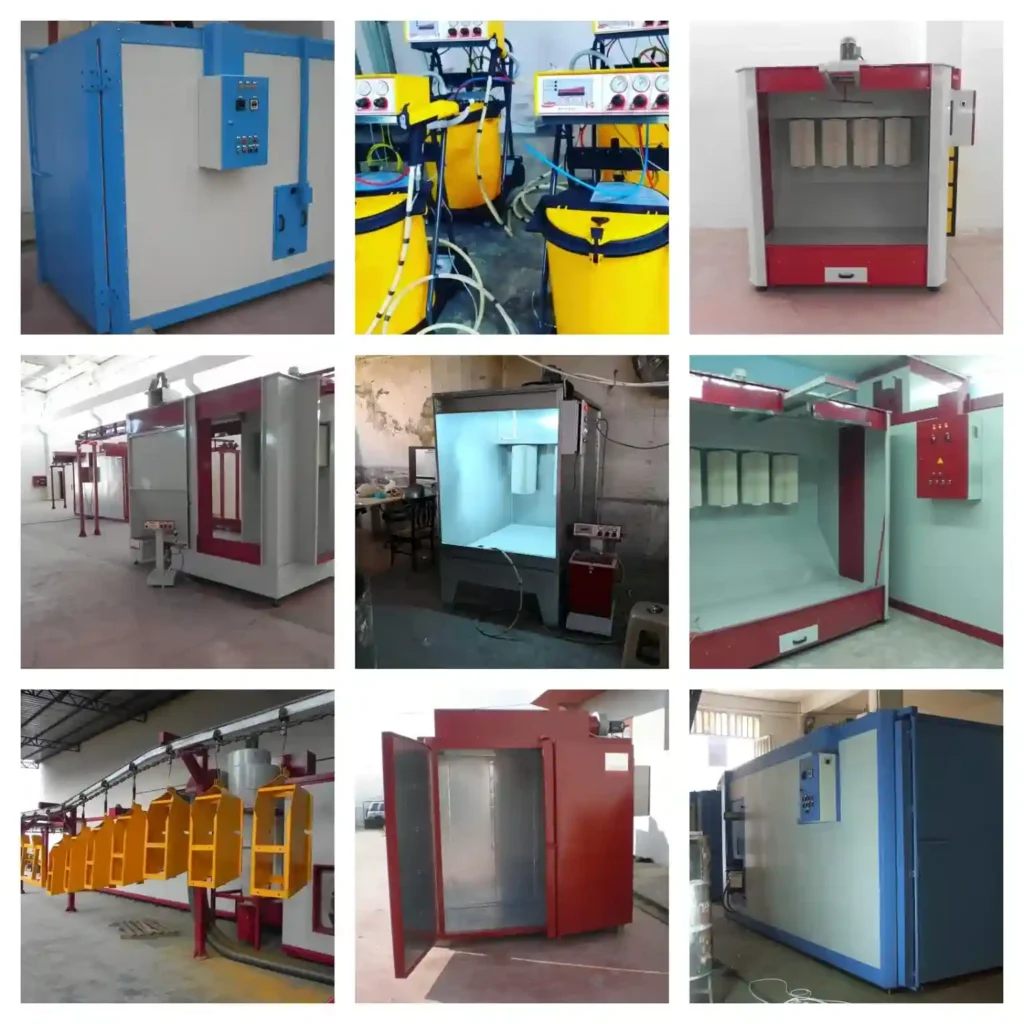
Powder coating equipment is used to apply a thin layer of powder over a metal surface. This type of coating is applied by an electrostatic process and is a very popular method for finishing metal parts.
This type of equipment can be divided into two main categories: automatic and manual. Automatic booths are more popular because they provide better production rates, but they are also more expensive.
A powder booth is an enclosure in which the powder-coating process takes place. Powder-coating equipment includes an oven where the parts are heated to activate the powder, a gun that sprays or brushes on the powder, a conveyor belt that moves parts through the oven, and cartridge-type guns for applying thicker coatings with less overspray.
Powder coating is a technique that is used to provide a finish to metal parts. This technique has been in use for many years and it is still one of the most popular techniques today.
Powder coating equipment consists of booths, ovens, guns, machines, lines and conveyors. A booth can be either automatic or manual. An automatic booth is more expensive than a manual booth but it is also faster and more efficient.
Thermoset powder: Thermoset powders are the most common type of powder coating. They undergo an irreversible chemical reaction during the curing process, forming a hard, crosslinked network that is highly resistant to heat, chemicals, and scratches.
Thermoplastic powder: Thermoplastic powders do not undergo a chemical reaction during the curing process. Instead, they simply melt and fuse together when heated. This makes them less durable than thermoset powders, but they are also more re-flowable, which can be useful for certain applications.
Epoxy powder: Epoxy powders are known for their excellent corrosion resistance and chemical resistance. They are also very hard and durable. However, they can be brittle and are not as UV resistant as some other types of powder coating.
Polyester powder: Polyester powders are the most versatile type of powder coating. They offer a good balance of properties, including durability, corrosion resistance, UV resistance, and chemical resistance. They are also available in a wide range of colors and finishes.
Polyurethane powder: Polyurethane powders are known for their flexibility and toughness. They are also very resistant to abrasion and impact. However, they are not as heat resistant as some other types of powder coating.
Acrylic powder: Acrylic powders are known for their excellent UV resistance and weather resistance. They are also very glossy and have a high scratch resistance. However, they are not as chemically resistant as some other types of powder coating.
Nylon powder: Nylon powders are known for their excellent chemical resistance and abrasion resistance. They are also very flexible and impact resistant. However, they are not as heat resistant as some other types of powder coating.
Fluorocarbon powder: Fluorocarbon powders are known for their excellent chemical resistance, UV resistance, and non-stick properties. They are also very durable and easy to clean. However, they are relatively expensive.
Silica powder: Silica powders are used as fillers and extenders in powder coatings. They can help to improve the adhesion, flow, and leveling of the coating.
Metal flake powder: Metal flake powders are used to create decorative finishes. They can be used to add sparkle, shine, or a metallic look to a powder coating.
Not only do we manufacture our powder coating equipment, we also ship them worldwide to your facility with care
We’re not just the manufacturers of your powder coating equipment, we’re also your worldwide delivery partners.
At EMS Powder Coating Equipment, we understand that getting your powder coating equipment to you quickly and safely is just as important as manufacturing it to the highest standards. That’s why we offer worldwide delivery services to all of our customers.
We work with a network of experienced and reliable shipping partners to ensure that your equipment arrives on time and in perfect condition. We also offer a variety of shipping options to fit your budget and needs.
Whether you need your equipment shipped to a local address or to an international destination, we can help. We’ll work with you to choose the best shipping option for your needs and to keep you updated on the status of your shipment every step of the way.
So when you choose EMS for your powder coating equipment, you’re not just getting the best products on the market, you’re also getting the best possible delivery experience.
Contact us today to learn more about our worldwide delivery services.
